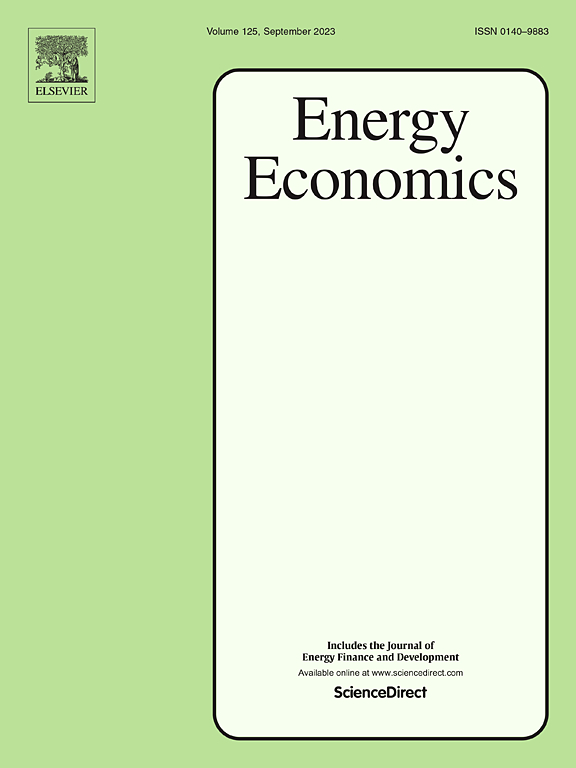ESG偏好的经济和环境影响建模:一般均衡方法
IF 14.2
2区 经济学
Q1 ECONOMICS
引用次数: 0
摘要
本研究建立了一个多部门动态随机一般均衡(DSGE)模型,包括家庭、中间产品生产商(棕色和绿色企业)、最终产品生产商、中央银行和中央政府。它系统地考察了ESG偏好影响企业层面投入产出关系和碳排放的动态传递机制。该模型包含了三个创新要素:碳排放对社会福利的负效用,棕色和绿色企业之间传导路径的明确区分,以及企业层面ESG激励的重新概念化。对四种不同冲击——家庭绿色投资偏好、棕色企业担保比率、减排努力和排放税——的模拟分析揭示了几个关键动态。值得注意的是,尽管居民绿色投资偏好的增加导致棕色企业的棕色投资在短期内下降,但从长期来看,棕色企业的棕色投资逐渐恢复,排放存量仍然减少。尽管市场对棕色企业ESG绩效的预期提高可以提高它们的产出,但这可能会削弱它们减少排放和加剧污染的动机。同时,加大减排力度虽然在短期内改善了环境,但对绿色企业投资产生了持续的抑制作用。此外,排放税的增加对绿色企业和环境产生了长期的好处,尽管对棕色企业产生了持续的负面影响。本研究为ESG投资的经济和环境影响评估建立了一个动态分析框架,为推进可持续金融和优化减排政策提供了重要的理论见解。本文章由计算机程序翻译,如有差异,请以英文原文为准。
Modeling the economic and environmental effects of ESG preferences: A general equilibrium approach
This study develops a multi-sector Dynamic Stochastic General Equilibrium (DSGE) model encompassing households, intermediate goods producers (brown and green firms), final goods producers, a central bank, and a central government. It systematically examines the dynamic transmission mechanisms through which ESG preferences influence firm-level input-output relationships and carbon emissions. The model incorporates three innovative elements: the disutility of carbon emissions on social welfare, explicit differentiation of transmission pathways between brown and green firms, and reconceptualized firm-level ESG incentives. Simulation analyses of four distinct shocks—household green investment preference, brown firm collateral ratio, emission reduction effort, and emission tax—reveal several key dynamics. Notably, while increased household green investment preference leads to a short-term decline in brown firms’ brown investment, such investment gradually recovers in the long term, and emission stocks still see a reduction. Although heightened market expectations regarding brown firms’ ESG performance can boost their output, they may weaken their motivation to reduce emissions and exacerbate pollution. Meanwhile, while enhanced emission reduction efforts improve the environment in the short term, they exert a sustained dampening effect on investment in green firms. Furthermore, emission tax increases yield long-term benefits for green firms and the environment, despite exerting persistent negative impacts on brown firms. This research establishes a dynamic analytical framework for assessing the economic and environmental impacts of ESG investment, providing significant theoretical insights for advancing sustainable finance and optimizing emission reduction policies.
求助全文
通过发布文献求助,成功后即可免费获取论文全文。
去求助
来源期刊

Energy Economics
ECONOMICS-
CiteScore
18.60
自引率
12.50%
发文量
524
期刊介绍:
Energy Economics is a field journal that focuses on energy economics and energy finance. It covers various themes including the exploitation, conversion, and use of energy, markets for energy commodities and derivatives, regulation and taxation, forecasting, environment and climate, international trade, development, and monetary policy. The journal welcomes contributions that utilize diverse methods such as experiments, surveys, econometrics, decomposition, simulation models, equilibrium models, optimization models, and analytical models. It publishes a combination of papers employing different methods to explore a wide range of topics. The journal's replication policy encourages the submission of replication studies, wherein researchers reproduce and extend the key results of original studies while explaining any differences. Energy Economics is indexed and abstracted in several databases including Environmental Abstracts, Fuel and Energy Abstracts, Social Sciences Citation Index, GEOBASE, Social & Behavioral Sciences, Journal of Economic Literature, INSPEC, and more.
 求助内容:
求助内容: 应助结果提醒方式:
应助结果提醒方式:


